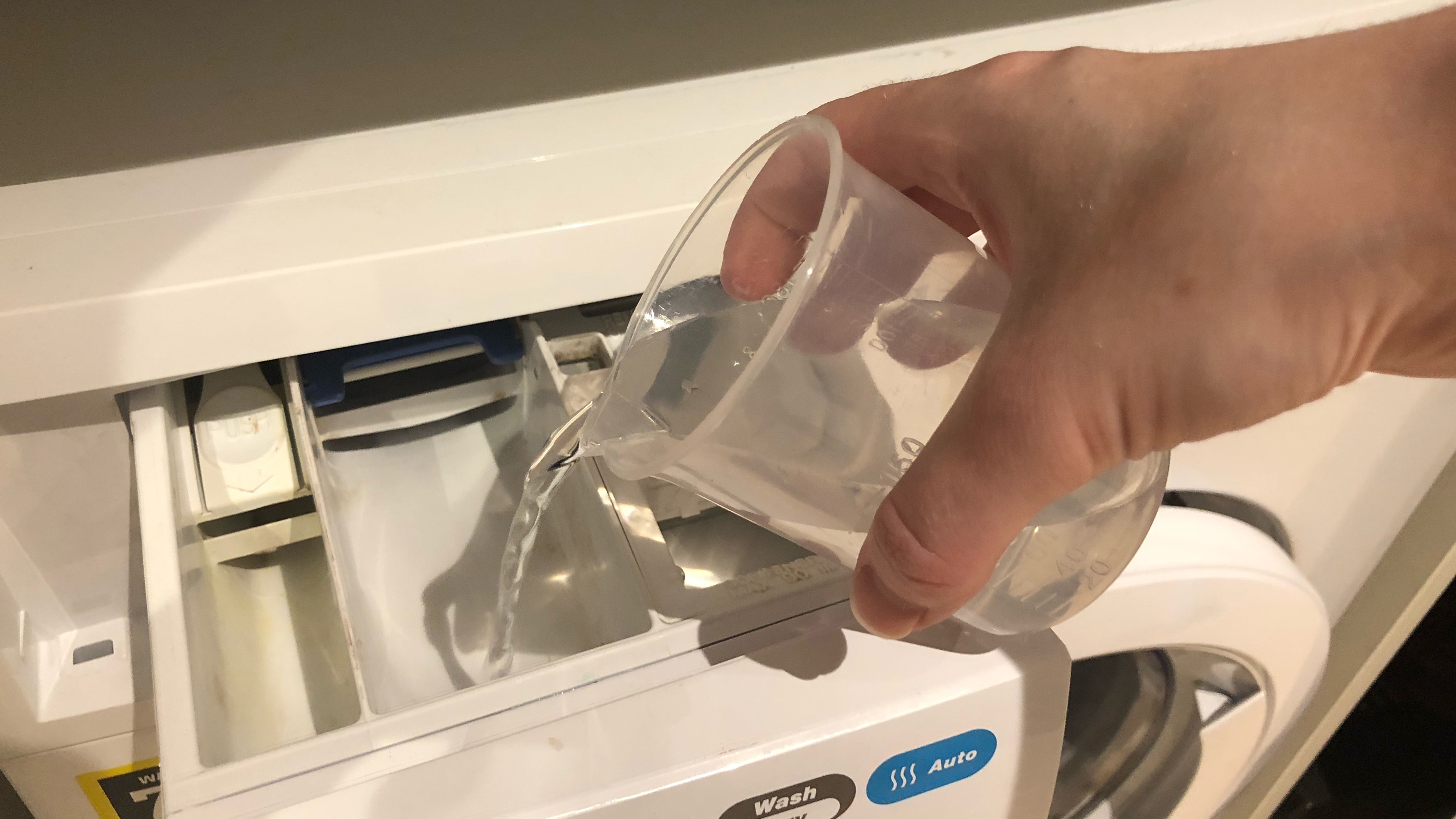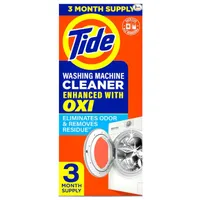How to clean a washing machine
Clothes starting to smell? Here’s how to clean a washing machine

If your washer has started to smell as of late, you may need to learn how to clean a washing machine. Because washing machines handle our dirty laundry, it’s all too easy to forget that they too need cleaning once in a while. Even the best washing machines require this, otherwise mold, limescale and soap scum can build up within, making your machine smell musty and potentially spreading to your laundry in the long run. In the worst case scenario, an unclean washing machine can even lead to expensive repairs, so it’s important that you keep on top of this if you want your washer to last longer.
Not sure where to start? We’re here to help. While cleaning a washing machine may sound like a daunting task, it’s actually very straightforward and all it requires is a few household products and some elbow grease. Here, we will take you through everything you need to do step-by-step, whether you’re cleaning a front load or a top load washer, so you can get your machine running like new. Here’s how to clean a washing machine.
How often should you clean your washing machine?
First, take a look at your manual to see if your washing machine comes with any maintenance cycles. It should advise you how and how often to run these. It’s always best to follow what your manufacturer recommends.
•Either a washing machine cleaner, white distilled vinegar or bleach
•Baking soda
•Toothbrush
•Microfiber cloth
If no advice is given, it’s good practice to deep clean your machine once a month depending on how often you use it. Between washes, you should also clean out the gasket (check there’s nothing loose caught there which might damage the machine) and leave the door and dispenser drawer open to prevent mold.
What should I use to clean my washing machine?
- The best way to clean a washing machine is with a designated cleaner such as Tide Washing Machine Cleaner. These have been formulated to shift all of the grease and grime without damaging the machine.
- Bleach is another popular option. While this is strong and will get the job done, it’s worth flagging that the dosage needs to be spot on, otherwise it can over-foam and damage the machine. This might invalidate your washer’s warranty as well. If you often clean with bleach, make sure you don’t make this mistake.
- White distilled vinegar is another effective cleaner and a sustainable option. However, vinegar will erode rubber over time, so you shouldn’t use this method frequently.
- Never mix bleach with vinegar — it creates a lethal chlorine gas
Tide Washing Machine Cleaner with OXI: $8 @ Amazon
Suitable for front and top loading washing machines, Tide's deep cleaning odor eliminator contains 3 pre-measured individual packets for monthly use. The cleaner also had the power of OXI and TAED to boost cleaning action on your washing machine by 20%.
How to clean a front load washer

1. Empty the drain hose
Water collects and can sit in the base of your machine for a long time, so it’s important to drain it every so often. The drain filter can also get clogged, so it’s an opportunity to clear out any foreign objects too. Before doing this, you should unplug the appliance for safety. Typically, there is a small panel on the lower-front of your machine, on either the left or right side. If you open this you will find a small hose and a dial, or just a dial. First, place down some towels. If you have a hose, grab a bowl and drain it by unplugging it. This may take a few trips to the sink! If you just have a dial, you need to open it very slowly and funnel the water into a shallow tray until it’s empty.
2. Clean the washing machine filter
Once the water has stopped, you can give the filter a clean. Unscrew it until it can be fully removed and clear out any small objects. Check both the filter itself and its reservoir for any foreign objects. Once clear, give the filter a clean by running it under hot running water and a scrub with the toothbrush if necessary. You can then replace the filter and the hose.

3. Clean the rubber seal on a washing machine
Next, you’re going to tackle the door and the gasket. Depending on what you’re planning to use later, either bleach or vinegar can be diluted to scrub away any mould on the seal — use a toothbrush if necessary. Use the same solution to clean the inside of the door as well, looking out for any dirt traps.
You can also use a crevice brush to clean between the gasket and the drum.
Get instant access to breaking news, the hottest reviews, great deals and helpful tips.
4. Clean the washing machine drawer

If you pull out your detergent drawer, you should spot a small release tab which will let you completely remove it. If in doubt, check the manual and don’t force it. Once out, let the drawer soak in hot, soapy water and scrub out any detergent residue, paying particular attention to the softener compartment. Rinse and dry, then re-insert.

5. Deep clean a washing machine
If you’ve chosen to use a washing machine cleaner, then simply follow the instructions. If you want to use bleach or vinegar, then add one of the following measurements to your detergent drawer and run the hottest wash your machine will allow. Remember, do not mix bleach and vinegar together for your own safety.
- ¼ cup (60ml) of liquid chlorine bleach
- 2 cups of white distilled vinegar
6. Clean the washing machine with baking soda
To give your washing machine a final cleanse, you can use baking soda. This will help deodorize it and shift any remaining grime. Add ½ cup directly to the drum and run the hottest setting once again.
Relative Foods Baking Soda for Cooking & Cleaning, 5lb: was $18 now $17 @ Amazon
This bulk bag of baking soda is a natural deodorizer, cleaner and stain remover, and it can also be used to make homemade toothpaste and bath bombs. Natural and pure, with no additives or preservatives, it is also ideal for baking.
7. Clean the outside of the machine
With a damp microfiber cloth, give the outside of the machine, including the controls, a once over.
How to clean a top load washing machine
1. Follow the instructions
If you’re using a washing machine cleaner, you will need to directly follow the instructions, which usually just involves chucking a tablet into the tub.
2. How to clean with vinegar or bleach
If you want to use bleach or vinegar, set the machine to its highest load size on the hottest and longest setting. Let it fill with water to the top, but before it begins to agitate, add either of the following directly to the water. Again, do not mix these together.
- ¼ cup (60ml) of liquid chlorine bleach
- 2 cups of white distilled vinegar
Close the door and allow it to agitate for 30 seconds or so to mix it in, then pause the timer, open the door and let it soak for an hour.

3. Clean the washing machine drawer
While you’re waiting, you’ve got time to tackle other areas. If your machine has a detergent drawer, remove it and soak it in a solution of hot, soapy water. Give it a scrub with a toothbrush to reach difficult areas and shift any remaining detergent or fabric softener. Once clean, replace it. While you’ve got the toothbrush out, scrub around the rim of the door and the top of the agitator using the solution in the machine. Look out for any signs of mold inside the machine you can reach as well.
4. Clean the outside of the machine
Using a damp microfiber cloth, give the body and controls a wipe over. Once you’ve waited an hour, you can close the door and let the machine finish the cycle.
5. Clean the washing machine with baking soda
If your washing machine was particularly smelly, baking soda is an extra step to help deodorize. Simply add ½ cup to the drum and run the same setting again. Baking soda will also help with shifting any final stains
6. Final touches
Once this wash has finished, use a damp microfiber cloth to give the inside of the machine a final wipe.
And that’s it, your machine should be spotless! If you can smell any residual cleaning solution or bleach, feel free to run another cycle.

Tips to avoid smelly washing
- Leave the door and drawer ajar between washes.
- Don’t leave your wet clothes sitting in the drum, not even after a drying program, as the clothes can still be damp.
- Use your maintenance cleaning program as often as the manufacturer recommends. If you don’t have one and want to quickly rinse the machine, you can just run an empty cycle on the hottest setting to wash away any residual detergent.
- Use the correct amount of detergent based on how stained your clothes are and how hard your water is. Using too much detergent can actually make things worse as the water can’t effectively rinse it away, leaving residual soap on the clothes and in the machine.
Want more cleaning tips? Well here's how to remove common Thanksgiving Day stains quickly and easily, how to clean a microfiber cloth, how to clean a dishwasher, how to wash a pillow, and how to clean a cast iron skillet and remove rust.

Katie Mortram used to be a Homes Editor for Tom's Guide, where she oversaw everything from kitchen appliances to gardening tools, as well as smart home tech. Specializing in providing expert advice for cleaning and home manintenance, she now works as Household Advice Editor for Good Housekeeping.


